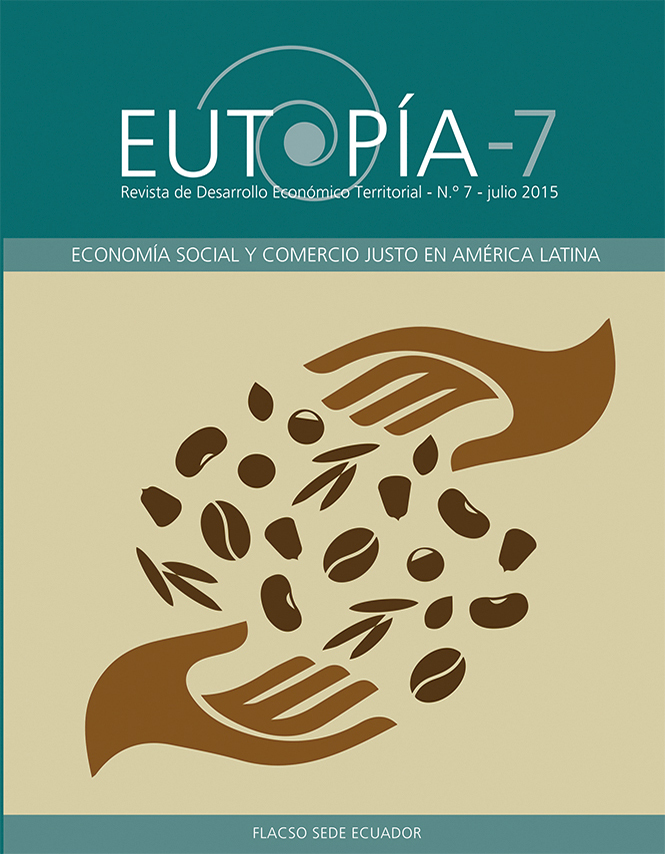Social economy and marketing for organic products in Cusco, Peru. ¿Initial steps to developing an alternative strategy?
Main Article Content
Abstract
Since 2010, the marketing channels for organic products in the city of Cusco, in southern Peruvian Andes, have been multiplying and diversifying: eco-fairs, specialty stores, organic food baskets, directs sales to restaurants, etc. Most of the demand comes from tourists and resident foreigners but also from some Peruvian residents. Some of these marketing experiences relate to the principles of social economy. In this paper we study to what extent these principles are being implemented successfully and we try to assess the socio-economic impacts of these initiatives at the territorial level. On the one hand, new commercial and social relations are emerging but, on the other hand, these experiences remain marginal and fragile: they include few producers, are affected by organizational problems, are lacking public support and certification systems, etc. These difficulties raise questions about the sustainability of these initiatives and their socially-oriented dimension. However, solutions based on these new dynamics can also be identified.
Downloads
Article Details

Eutopía, Revista de Desarrollo Económico Territorial, operates under Creative Commons Attribution-No Derivative Work 3.0 unported (CC BY-ND 3.0).
The authors who publish in Eutopía accept these terms:
You are free to share / copy and redistribute the material in any medium or format for any purpose, including commercial. Therefore, authors retain the copyright and cede to the journal the right of the first publication (CC by-ND 3.0), which allows third parties the redistribution, commercial or noncommercial, of what is published as long as the article circulates without changes.
The following conditions exist for the authors:
Recognition - you must recognize the authorship, provide a link to the license and indicate whether changes have been made. You can do this in any way reasonable, but not in a way that suggest that has the support of the licensor or receives it by the use he makes.
Without Derivative Work – If you remixed, transform or create a work from the original material, you cannot broadcast the modified material.
For more details, visit the page of Creative Commons (CC).
References
Bebbington, Anthony (2004). “NGOs and uneven development: geographies of development intervention”. Progress in Human Geography, 28 (6), 725–745.
Caballero, Luis, Sergio Dumrauf, Edgardo González, Florencia Mainella, Mariana Moricz (2010). “Los procesos organizativos de la agricultura familiar y la creación de ferias y mercados de economía social”. Otra Economía, n°7, Vol. IV, 26-41.
Cabanes Morote, Mar y José Daniel Gómez López (2014). “Economía social y Soberanía alimentaria. Aportaciones de las cooperativas y asociaciones agroecológicas de producción y consumo al bienestar de los territorios”. CIRIEC-España, n°82, 127-154.
Defourny, Jacques, Patrick Develtere y Bénédicte Fonteneau (1999). L’économie sociale au Nord et au Sud. Paris, Bruxelles: De Boeck Université. Deverre, Christian y Claire Lamine (2010). “Les systèmes agroalimentaires alternatifs. Une revue de travaux anglophones en sciences sociales”. Économie rurale, n°317, 57-73.
Earls, John (2006). La agricultura andina ante una globalización en desplome. Lima, PUCP-CISEPA.
Frutos de la tierra, marca colectiva (2015). “Nosotros”. Disponible en http://frutosdelatierra.com/index.php/quienes-somos (visitada 4 de junio de 2015).
Garibay Salvador, V. y Eduardo Zamora (2003). Producción Orgánica en Nicaragua: limitaciones y potencialidades. Managua: SIMAS. Gobierno Regional del Cusco (2014). Ordenanza regional n° 067-2014-CR/GR.CUSCO. Cusco.
Heinisch, Claire, Pierre Gasselin y Guy Durand (2014). “Circuits alimentaires de proximité dans les Andes. Vers une reconnaissance de l’agriculture familiale et paysanne”. Économie rurale, n° 343, 71-86.
INEI-Instituto Nacional de Estadística e Informática (2012), “Perú: Estimaciones y Proyecciones de Población Total por Sexo de la Principales Ciudades, 2000-2015”. Lima.
INEI-Instituto Nacional de Estadística e Informática (2007) “Censos Nacionales 2007: XI de Población y VI de Vivienda”. Lima.
IFOAM-International Federation of Organic Agriculture Movements (2015). “Definition of Participatory Guarantee Systems”. Disponible en http://frutosdelatierra.com/index.php/quienes-somos (visitada 15 de marzo de 2015).
Laville, Jean-Louis (2007). L’économie solidaire. Une perspective internationale, Hachette Littératures.
Mesclier, Evelyne (1991). Les paysans face au marché dans des situations d’instabilité : étude comparative dans les Andes du Pérou. Disertación doctoral en geografía. Université de Paris VII, Francia.
Moine, Alexandre (2007). Le territoire: comment observer un système complexe, Paris, Editions L’Harmattan.
Nigh, Ronald y Alma Amalia González Cabañas (2015). “Reflexive consumer Markets as Opportunities for New Peasant Farmers in Mexico and France: Constructing Food Sovereignty through Alternative Food Networks”. Agroecology and Sustainable Food Systems, 39:3, 317-341.
Pérez-Vitoria, Silvia (2005). Les paysans sont de retour, Paris, Actes Sud.
Rebaï, Nasser (2013). “L’agroécologie peut-elle être une voie de développement durable pour les paysanneries andines?”. En Dynamiques de développement et enjeux de gouvernance. Espaces ruraux/Espaces urbains, 173-184, Abdoul Hameth Ba y Jérôme Lombard (directores). Paris: L’Harmattan.
Rebaï, Nasser (2010). “Agricultura comercial y resistencia territorial: Análisis de las relaciones campo-ciudad en la provincia del Azuay”. Eutopía, n°1, 69-81.
Richer, Madeleine (2005). “Innovación social y desarrollo local en un municipio andino”. Revista Venezolana de Economía Social, n°9, 49-65.
Ugas Roberto (2009). “El protagonismo invisible de la agricultura orgánica”. Revista Agraria, n°112, 4-6.
Van der Ploeg, Jan Douwe (2008). The new peasantries-Struggles for autonomy and sustainability in an era of empire and globalization. London, UK, Earthscan.
Wú Guin, Silvia y Fernando Alvarado de la Fuente (2008). Ideas para la Agricultura Ecológica Desde la vivencia en el movimiento agroecológico peruano y latinoamericano. Perú: Centro IDEAS.
Wú Guin, Silvia (2008). “El desarrollo del mercado ecológico local en cuatro regiones delPerú”. LEISA revista de agroecología. No. 1, Vol. 24. Pp 30-33.






